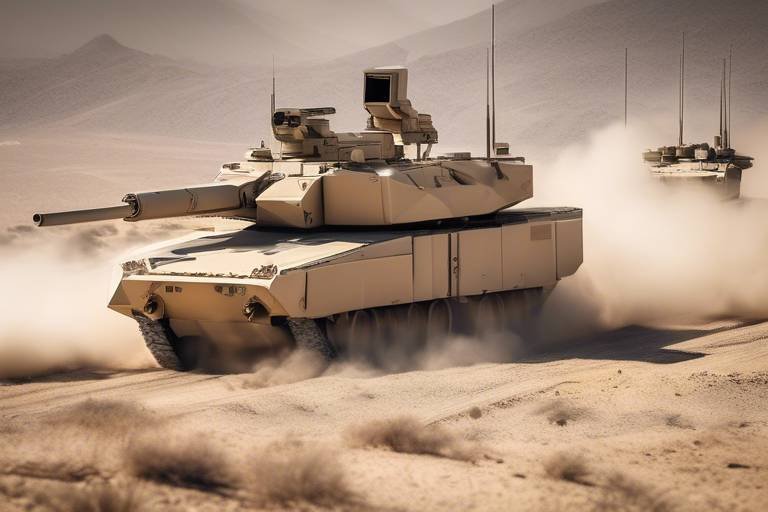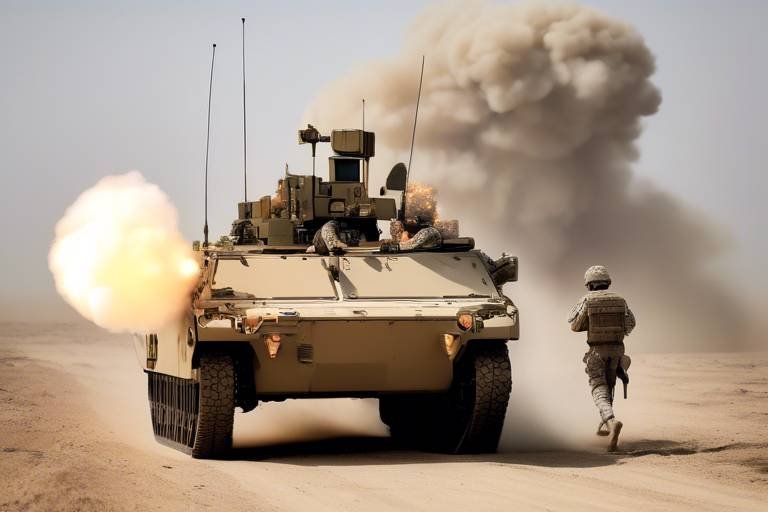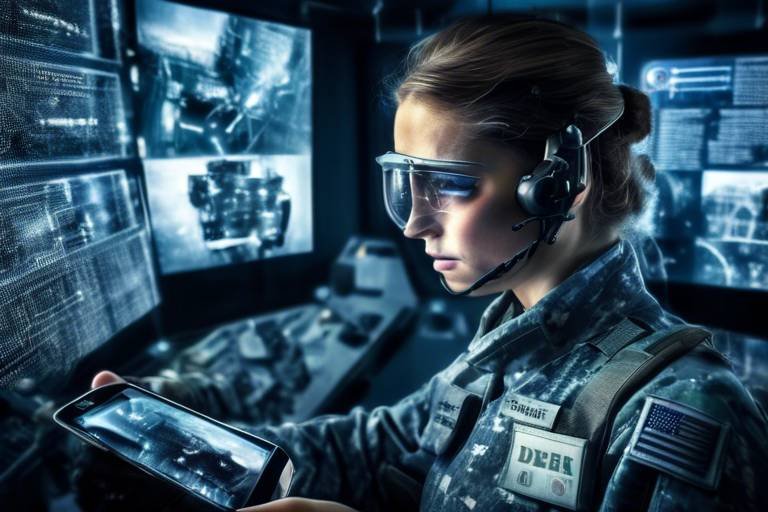The Impact of National Defense Strategies on Technology Development
The intricate dance between national defense strategies and technological advancement is a fascinating narrative that has evolved over centuries. At its core, this relationship is driven by the pressing needs of military forces to maintain a competitive edge, which in turn fuels innovation across various sectors. Think about it: when nations prioritize defense, they inadvertently create a fertile ground for technological breakthroughs. This symbiotic relationship not only shapes military capabilities but also influences civilian industries, leading to advancements that permeate everyday life. For instance, technologies originally developed for military applications, such as GPS and the internet, have become integral to modern society.
As we delve deeper into this topic, we’ll uncover the historical context that has shaped current defense strategies, explore the vital role of government funding, and examine how public-private partnerships have catalyzed innovation. Moreover, we will highlight the emerging technologies that are redefining defense capabilities and their implications for civilian life. So, buckle up as we embark on this exploration of how national defense strategies are not just about weapons and warfare but are also about shaping the future of technology itself.
Understanding the evolution of national defense strategies provides a backdrop against which we can appreciate their impact on technology development. From the Cold War era, where the arms race spurred advancements in missile technology and surveillance systems, to the War on Terror, which emphasized the need for counter-terrorism technologies, each historical phase has left an indelible mark on military innovation. The creation of the Defense Advanced Research Projects Agency (DARPA) in the 1950s is a prime example of how a strategic response to perceived threats can lead to groundbreaking technological developments. DARPA was responsible for the creation of the ARPANET, which laid the groundwork for the modern internet.
Furthermore, the rapid pace of technological change today demands that national defense strategies evolve continuously. The integration of cyber capabilities into military strategy is a direct response to the increasing reliance on digital infrastructure. This shift not only reflects the changing nature of warfare but also highlights how defense strategies can drive innovation in areas such as cybersecurity and artificial intelligence.
Government funding is a cornerstone of technological advancement in defense sectors. The investment in research and development (R&D) is crucial, as it paves the way for innovation and the creation of new technologies. According to a recent report, the U.S. government allocated over $700 billion to defense spending, with a significant portion directed towards R&D initiatives. This funding supports a myriad of projects, from developing advanced weaponry to enhancing communication systems and improving soldier safety.
The impact of this funding is evident in various technological advancements. For instance, the development of unmanned aerial vehicles (UAVs), or drones, has revolutionized military operations. Initially funded by defense budgets, UAV technology has now found applications in agriculture, disaster response, and even delivery services. This illustrates how military needs can catalyze innovations that ultimately benefit civilian sectors as well.
Collaboration between government and private sectors significantly enhances technology development, enabling efficient resource allocation and fostering innovation in defense-related projects. These public-private partnerships (PPPs) allow for the pooling of knowledge, expertise, and resources, resulting in more effective solutions to complex challenges. For example, companies like Lockheed Martin and Boeing work closely with the government to develop cutting-edge technologies, from fighter jets to satellite systems.
Examining specific case studies reveals how successful public-private partnerships have led to groundbreaking technological advancements in defense applications. One notable example is the collaboration between the U.S. Department of Defense and tech giants like Google and Amazon in developing cloud computing solutions that enhance data management and analysis capabilities for military operations. These partnerships not only accelerate technological advancements but also ensure that the military can leverage the latest innovations in a rapidly evolving tech landscape.
Despite their benefits, public-private partnerships face challenges, including differing priorities and bureaucratic hurdles that can hinder effective collaboration and innovation. For instance, while private companies often prioritize profit and marketability, government agencies may focus on security and compliance. These contrasting objectives can lead to friction and delays in project implementation. Moreover, the bureaucratic nature of government processes can slow down the agility needed in tech development, making it crucial for both sectors to find common ground and align their goals.
Technological innovations driven by national defense strategies often spill over into civilian applications, resulting in advancements that benefit society as a whole. The development of GPS technology is a classic example of this phenomenon. Initially created for military navigation, GPS has transformed numerous industries, including transportation, agriculture, and emergency services. Similarly, advancements in medical technology, such as telemedicine and robotic surgery, have roots in military research and development.
The exploration of emerging technologies, such as artificial intelligence (AI) and cybersecurity, illustrates how national defense strategies are shaping the future of technology development. As nations invest in these cutting-edge technologies, the implications for both military and civilian sectors are profound. The integration of AI into defense strategies is enhancing decision-making processes and operational efficiencies, making military operations more effective and responsive to threats.
AI is revolutionizing defense strategies, enhancing decision-making processes and operational efficiencies, and driving significant technological advancements in various military applications. For instance, AI algorithms are being used for predictive analytics, allowing military leaders to anticipate potential threats and make informed decisions quickly. This technology extends beyond the battlefield, influencing logistics and supply chain management in both military and civilian contexts.
As cyber threats grow, national defense strategies focus on developing advanced cybersecurity technologies, influencing both military and civilian sectors to enhance security measures. The increasing frequency of cyberattacks on critical infrastructure has prompted governments to invest heavily in cybersecurity solutions, which not only protect military assets but also safeguard civilian data and systems. The collaboration between defense agencies and tech companies in this arena is crucial for developing robust security frameworks that can withstand evolving threats.
- How do national defense strategies influence civilian technology?
National defense strategies often lead to technological advancements that spill over into civilian applications, improving various sectors such as healthcare, transportation, and communication. - What role does government funding play in technology development?
Government funding is essential for driving research and development in defense, enabling the creation of innovative technologies that can enhance military capabilities and benefit civilian industries. - What are some examples of successful public-private partnerships in defense?
Collaborations between the government and private companies, like those involving DARPA, have led to significant advancements in technologies such as drones and cybersecurity solutions.

Historical Context of Defense Strategies
Understanding the historical context of national defense strategies is crucial for grasping their profound impact on technology development. Over the decades, various global conflicts and geopolitical tensions have shaped military approaches, leading to significant advancements in technology. For instance, the Cold War era was marked by an intense arms race between the United States and the Soviet Union, which not only focused on nuclear capabilities but also spurred innovations in various fields, including aerospace, computing, and telecommunications.
During World War II, the necessity for rapid technological advancements became evident. The development of radar technology and the first programmable computers were direct responses to military needs. This era also saw the birth of the Manhattan Project, which not only revolutionized warfare with the introduction of nuclear weapons but also laid the groundwork for modern physics and engineering disciplines. The urgency of defense needs often acts as a catalyst for innovation, pushing scientists and engineers to develop solutions that may not have been pursued in peacetime.
In the post-war period, the focus shifted towards deterrence strategies and the need for advanced reconnaissance technologies. The Vietnam War further highlighted the importance of technological superiority, leading to innovations in surveillance and communication technologies. The introduction of GPS and advanced satellite systems can be traced back to military requirements, which eventually found their way into civilian life, transforming navigation and logistics.
Furthermore, the rise of asymmetric warfare in the late 20th century, characterized by conflicts involving non-state actors, has necessitated a reevaluation of defense strategies. This shift has led to the development of technologies that enhance situational awareness and intelligence gathering, such as drones and advanced data analytics. The interplay between military needs and civilian applications has become increasingly blurred, showcasing how defense strategies can influence broader technological landscapes.
To illustrate the evolution of defense strategies and their impact on technology development, consider the following table:
| Era | Key Events | Technological Advancements |
|---|---|---|
| World War II | Global conflict, Manhattan Project | Radar, programmable computers |
| Cold War | Arms race, space race | Aerospace technologies, telecommunications |
| Vietnam War | Asymmetric warfare | GPS, advanced surveillance |
| 21st Century | Cyber threats, terrorism | Cybersecurity, AI applications |
In conclusion, the historical context of defense strategies reveals a dynamic relationship between military needs and technological advancements. Each conflict and geopolitical shift not only influences military tactics but also drives innovation across various sectors. This ongoing evolution underscores the importance of understanding how national defense strategies shape the future of technology development.
- How have historical conflicts influenced technology development? Historical conflicts often create urgent needs for new technologies, leading to innovations that can be applied in both military and civilian contexts.
- What role does government funding play in defense technology? Government funding is essential as it supports research and development initiatives necessary for technological advancements in defense.
- Can advancements in defense technology benefit civilian life? Yes, many technologies developed for military purposes, such as GPS and the internet, have found significant applications in civilian life.

The Role of Government Funding
When we talk about the interplay between national defense strategies and technological advancement, one of the most significant players in this arena is undoubtedly government funding. It’s like the fuel that powers the engine of innovation. Without it, many groundbreaking technologies might never see the light of day. This funding is not just about throwing money at problems; it's a strategic investment aimed at enhancing national security and fostering technological growth across various sectors.
Consider this: the military often requires cutting-edge technologies to maintain an edge over potential adversaries. This need drives the government to allocate substantial resources into research and development (R&D). For instance, in recent years, the U.S. Department of Defense has significantly increased its budget for R&D, recognizing that innovation is key to addressing both current and future threats. This funding supports a range of projects, from advanced weaponry to artificial intelligence systems, which ultimately contribute to a more robust defense strategy.
Moreover, government funding can take many forms, including grants, contracts, and direct investments. These financial avenues not only support large defense contractors but also encourage startups and smaller companies to innovate. By providing financial backing, the government creates a nurturing environment for creativity and technological breakthroughs. This is crucial because, in many cases, smaller firms can pivot more quickly and explore innovative solutions that larger corporations might overlook.
As we delve deeper into the impact of government funding, it’s essential to acknowledge the concept of public-private partnerships. These collaborations are vital in maximizing the effectiveness of government investments. By pooling resources and expertise, both the public sector and private companies can work together to tackle complex challenges. For example, when the government partners with tech firms to develop cybersecurity solutions, they can harness the agility of the private sector while ensuring that national security needs are met.
However, it’s important to note that the relationship between government funding and technology development is not without its challenges. Bureaucratic red tape can sometimes slow down the process, making it difficult for innovative projects to get off the ground. Additionally, differing priorities between government agencies and private companies can lead to misalignment, ultimately hindering the potential for groundbreaking advancements.
In summary, government funding plays a pivotal role in driving technological advancements in defense. It not only provides the necessary resources for innovation but also fosters collaboration between various sectors. As we continue to explore the relationship between national defense strategies and technology development, it becomes clear that this funding is not just an investment in military capabilities; it’s an investment in the future of technology itself.

Public-Private Partnerships
Public-private partnerships (PPPs) have become a crucial element in the landscape of defense technology development. These collaborations between government entities and private sector companies are not just about sharing resources; they represent a strategic alliance that leverages the strengths of both sectors. The government often brings funding and regulatory support, while private companies contribute innovation and expertise. This synergy is instrumental in addressing the complex challenges faced by modern defense systems.
One of the most compelling aspects of PPPs is their ability to accelerate technological advancements. For instance, through these partnerships, the defense sector has seen the rapid development of cutting-edge technologies such as unmanned aerial vehicles (UAVs) and advanced surveillance systems. These innovations not only enhance military capabilities but also have significant implications for civilian applications. Imagine a world where the same technologies that help secure our nation are also used in disaster response or environmental monitoring—this is the power of effective public-private partnerships.
However, the journey of collaboration is not without its bumps. There are inherent challenges that can hinder the effectiveness of these partnerships. For example, government agencies often operate under strict regulatory frameworks, while private companies may prioritize profit margins and shareholder interests. This can lead to a mismatch in objectives, resulting in friction and inefficiencies. Additionally, bureaucratic hurdles can slow down the innovation process, making it difficult for groundbreaking ideas to transition from concept to reality.
Despite these challenges, many successful case studies highlight the transformative potential of PPPs in defense technology. Take, for example, the collaboration between the U.S. Department of Defense and various tech companies in the development of cybersecurity solutions. These partnerships have led to significant advancements in protecting sensitive military data, showcasing how shared goals can lead to remarkable outcomes. The key takeaway here is that when both sectors align their missions, the results can be nothing short of revolutionary.
In conclusion, public-private partnerships represent a vital mechanism for driving innovation in defense technology. By fostering collaboration between the government and private companies, these partnerships not only enhance military capabilities but also pave the way for broader societal benefits. As we look to the future, the continued evolution of these partnerships will be essential in addressing the ever-changing landscape of national security and technological advancement.
- What are public-private partnerships? Public-private partnerships are collaborative agreements between government agencies and private sector companies aimed at achieving mutual goals, particularly in areas such as defense technology.
- Why are public-private partnerships important in defense? They are important because they combine the strengths of both sectors, leading to faster innovation, better resource allocation, and enhanced military capabilities.
- What challenges do public-private partnerships face? Challenges include differing priorities between the public and private sectors, bureaucratic hurdles, and potential misalignment of objectives.
- Can technologies developed through PPPs benefit civilians? Yes, many technologies initially developed for defense purposes often find applications in civilian sectors, enhancing public safety and improving quality of life.

Case Studies of Successful Collaborations
Throughout history, there have been numerous instances where public-private partnerships have led to remarkable advancements in defense technology. One of the most notable examples is the collaboration between the U.S. Department of Defense and major tech companies during the development of the Global Positioning System (GPS). Initially conceived for military navigation, GPS technology has revolutionized not just military operations but also civilian life, enabling everything from smartphone navigation apps to precision agriculture. This partnership exemplifies how military needs can drive technological innovation that ultimately benefits society at large.
Another compelling case is the collaboration between the U.S. military and Lockheed Martin in developing the F-35 Lightning II. This advanced stealth fighter jet incorporates cutting-edge technologies such as sensor fusion and advanced avionics, which were made possible through significant investment and collaboration between the military and private sectors. The F-35 program has not only enhanced military capabilities but has also spurred advancements in aerospace technology that have applications beyond defense, including commercial aviation.
Moreover, the partnership between the National Aeronautics and Space Administration (NASA) and private aerospace companies, such as SpaceX, showcases another dimension of successful collaboration. NASA's Commercial Crew Program, which aims to transport astronauts to the International Space Station, has leveraged private sector innovation to reduce costs and increase efficiency. The successful launch of the Crew Dragon spacecraft is a testament to how government initiatives can stimulate private innovation, leading to groundbreaking advancements in space technology.
However, it's essential to recognize that these collaborations are not without their challenges. Differences in organizational culture, conflicting priorities, and bureaucratic red tape can often create friction between government entities and private companies. Yet, when these partnerships work effectively, the results can be transformative. They not only enhance national security but also contribute to broader technological advancements that can have a lasting impact on society.
In summary, the case studies of GPS, the F-35 program, and NASA's partnerships highlight the dynamic interplay between government and private sectors in driving technological innovation. These collaborations exemplify how military needs can serve as a catalyst for advancements that extend far beyond the battlefield, ultimately enriching civilian life and fostering a culture of innovation.
- What are public-private partnerships in defense?
Public-private partnerships in defense refer to collaborative agreements between government entities and private companies aimed at developing technologies and solutions that enhance national security. - How do defense strategies influence civilian technology?
Technological advancements driven by defense strategies often spill over into civilian applications, leading to innovations that benefit various sectors, including healthcare, transportation, and communication. - What are some challenges faced in public-private collaborations?
Challenges include differing priorities between government and private sectors, bureaucratic hurdles, and potential conflicts of interest that may hinder effective collaboration.

Challenges in Collaboration
While public-private partnerships have the potential to drive significant advancements in technology, they are not without their challenges. One of the most prominent issues is the difference in priorities between government entities and private companies. Governments often focus on security and compliance, while private companies are driven by profit margins and market competitiveness. This divergence can lead to misunderstandings and misaligned goals, making it difficult to establish a cohesive strategy that satisfies both parties.
Moreover, the bureaucratic nature of government processes can stifle innovation. In many cases, government agencies must adhere to strict regulations and lengthy approval processes that can slow down the pace of technology development. For instance, while a private company might be ready to deploy a new technology, the government may require extensive testing and validation, which can delay implementation and frustrate private partners.
Another challenge arises from resource allocation. Government funding may not always match the needs of fast-paced technological advancements. This disparity can result in projects being underfunded, leading to compromises in quality and effectiveness. Additionally, the competitive landscape of the private sector means that companies may be hesitant to share sensitive information or collaborate openly, fearing that they might lose their competitive edge. This reluctance can hinder the flow of ideas and limit the potential for groundbreaking innovations.
To illustrate these challenges further, consider the following table that outlines some common obstacles faced in public-private partnerships:
| Challenge | Description |
|---|---|
| Misaligned Goals | Government focuses on compliance and security; private sector prioritizes profitability. |
| Bureaucratic Delays | Lengthy approval processes can slow down innovation and deployment. |
| Resource Allocation Issues | Inadequate funding can compromise project quality and effectiveness. |
| Information Sharing Hesitance | Companies may be reluctant to share sensitive data, hindering collaboration. |
In conclusion, while the collaboration between government and private sectors holds immense potential for technological advancements, it is essential to address these challenges head-on. By fostering open communication, aligning objectives, and streamlining processes, both parties can work together more effectively to drive innovation and enhance national defense strategies. Ultimately, overcoming these hurdles will not only benefit defense applications but also pave the way for broader technological progress that can positively impact society as a whole.
- What are public-private partnerships? Public-private partnerships are collaborations between government entities and private sector companies aimed at achieving common goals, particularly in technology development.
- Why are there challenges in collaboration? Challenges arise due to differing priorities, bureaucratic processes, resource allocation issues, and hesitance in information sharing.
- How can these challenges be overcome? Open communication, aligned objectives, and streamlined processes are essential for effective collaboration.
- What is the impact of successful collaborations? Successful collaborations can lead to significant technological advancements that enhance both defense capabilities and civilian applications.

Impact on Civilian Technology
When we think about national defense strategies, the first thing that often comes to mind is military might and geopolitical maneuvering. However, the ripple effects of these strategies extend far beyond the battlefield, significantly influencing civilian technology in ways that are often overlooked. Just like a stone thrown into a pond creates ripples, the innovations driven by defense needs can lead to advancements that touch everyday life. From the development of the internet to GPS technology, many civilian applications have their roots in military research and development.
One of the most fascinating aspects of this relationship is how technologies initially designed for defense purposes often find their way into civilian markets. For instance, consider the evolution of satellite technology. Originally developed for military reconnaissance, satellites now play a crucial role in weather forecasting, telecommunications, and navigation. This transformation highlights a vital point: the investment in defense technology can yield benefits that enhance the quality of life for civilians across the globe.
Moreover, the process of technology transfer from military to civilian sectors is not just coincidental; it is often a structured endeavor. Governments recognize the potential for dual-use technologies—those that serve both military and civilian functions. As a result, many defense agencies actively promote the commercialization of military innovations. This is where programs aimed at fostering public-private partnerships come into play, creating a bridge between defense contractors and civilian industries.
To illustrate this impact, let’s take a look at a few examples of how military innovations have transformed civilian technology:
| Military Innovation | Civilian Application |
|---|---|
| GPS Technology | Navigation systems in smartphones and vehicles |
| Internet | Global communication and information sharing |
| Drones | Aerial photography, delivery services, and agriculture |
| Advanced Materials | Lightweight and durable materials in consumer products |
As we can see from the table above, the intersection of military and civilian technology is rich with potential. The advancements made in the defense sector often set the stage for innovations that can be adapted for civilian use. This not only boosts the economy but also fosters an environment of continuous improvement and innovation.
However, it’s essential to recognize that this relationship is not without its challenges. The transition from military to civilian applications can be fraught with obstacles, including regulatory hurdles and the need for significant adaptation of technology to meet civilian needs. Additionally, there can be a cultural divide between military and civilian sectors, which can complicate collaboration efforts.
In conclusion, the impact of national defense strategies on civilian technology is profound and multifaceted. The innovations born from military necessity often pave the way for advancements that enhance our daily lives, creating a symbiotic relationship that benefits society as a whole. As we continue to navigate the complexities of modern warfare and technological advancement, it is crucial to foster an environment where these innovations can thrive and be adapted for civilian use, ensuring that the benefits of defense research extend far beyond the military.
- How does military technology influence civilian life?
Military technology often leads to innovations that are later adapted for civilian use, improving various aspects of daily life. - What are some examples of military technologies that became civilian innovations?
Examples include GPS technology, the internet, and advancements in materials science. - Are there challenges in transferring military technology to civilian applications?
Yes, challenges can include regulatory issues, cultural differences, and the need for adaptation to meet civilian needs. - Why are public-private partnerships important in this context?
These partnerships facilitate the transfer of technology and resources between military and civilian sectors, driving innovation.

Emerging Technologies in Defense
The realm of national defense is undergoing a seismic shift, driven by the rapid emergence of new technologies that are reshaping military strategies and operational capabilities. At the forefront of this transformation are innovations such as artificial intelligence (AI), cybersecurity advancements, and unmanned systems. These technologies not only enhance military effectiveness but also illustrate the profound connection between defense needs and technological progress.
Artificial intelligence is perhaps the most talked-about innovation in defense today. Imagine a world where military operations can leverage AI to analyze vast amounts of data in real-time, making split-second decisions that could mean the difference between success and failure. AI systems are being developed to assist in everything from logistics and supply chain management to predictive maintenance of military equipment. By utilizing machine learning algorithms, defense organizations can improve their operational efficiencies and reduce costs, ultimately leading to a more agile and responsive military force.
Moreover, the integration of AI in defense strategies is not just about enhancing existing capabilities; it is about redefining how military operations are conducted. For instance, AI can be employed in autonomous systems, which can carry out missions without direct human intervention. This shift raises questions about the ethical implications of using AI in combat scenarios, but it also opens up new avenues for reducing risks to human personnel and increasing mission success rates.
Equally critical is the focus on cybersecurity innovations. As the digital landscape becomes increasingly complex, the military faces heightened threats from cyber attacks that could cripple communication networks or compromise sensitive information. National defense strategies are now placing a significant emphasis on developing advanced cybersecurity technologies to safeguard against these threats. This includes everything from encryption techniques to sophisticated intrusion detection systems. The goal is to create a resilient cyber defense posture that can withstand and respond to ever-evolving cyber threats.
Interestingly, the advancements in cybersecurity driven by defense needs often trickle down to civilian applications. Technologies developed for military use—like robust encryption methods or secure communication protocols—find their way into the private sector, enhancing the security of businesses and individual users alike. This cross-pollination of ideas and technologies illustrates the broader impact of national defense strategies on society as a whole.
In addition to AI and cybersecurity, the development of unmanned systems, including drones and robotic vehicles, is revolutionizing defense operations. These systems are not only used for reconnaissance and surveillance but are also being adapted for combat roles, logistics, and even humanitarian missions. The flexibility and efficiency of unmanned systems allow military forces to conduct operations in environments that might be too dangerous for human personnel, thus expanding the operational scope of modern militaries.
As we look to the future, it's clear that the interplay between emerging technologies and national defense strategies will continue to evolve. The military's demand for cutting-edge solutions will drive innovation in various sectors, leading to advancements that could change the fabric of our everyday lives. The question remains: how will these technologies shape our world, and what ethical considerations must we address as we embrace these advancements?
- What are the key emerging technologies in defense? The key emerging technologies include artificial intelligence, cybersecurity innovations, and unmanned systems.
- How does AI impact military operations? AI enhances decision-making processes, improves operational efficiencies, and enables autonomous systems to conduct missions.
- What are the cybersecurity challenges faced by the military? The military faces threats from cyber attacks that could disrupt communication networks and compromise sensitive data.
- How do defense technologies benefit civilian sectors? Technologies developed for military use often find applications in civilian life, improving security measures for businesses and individuals.

Artificial Intelligence in Defense
Artificial Intelligence (AI) is not just a buzzword; it’s a game-changer in the realm of defense. Imagine a world where machines can analyze vast amounts of data in seconds, making decisions that could save lives and resources. This is not science fiction; it’s the reality of modern military operations. AI is revolutionizing how defense strategies are formulated and implemented, enhancing everything from logistics to combat tactics. With the ability to process information at lightning speed, AI systems can predict potential threats and recommend actions faster than any human could.
One of the most significant impacts of AI in defense is its ability to enhance decision-making processes. For instance, military commanders can leverage AI algorithms to assess battlefield conditions, analyze enemy movements, and even simulate various combat scenarios. This capability allows for a more informed, strategic approach to military operations. The integration of AI into defense systems also leads to improved operational efficiencies. Tasks that once required extensive manpower can now be automated, freeing up personnel for more critical roles.
Moreover, AI technologies are being utilized in various applications, including:
- Autonomous Vehicles: Drones and ground vehicles equipped with AI can conduct surveillance and reconnaissance missions without putting human lives at risk.
- Predictive Maintenance: AI can analyze equipment data to predict failures before they occur, ensuring military assets are always ready for action.
- Cyber Defense: AI systems can detect and respond to cyber threats in real-time, safeguarding sensitive military information.
The collaboration between defense agencies and tech companies has led to the rapid advancement of AI technologies. This partnership is crucial because it combines military expertise with cutting-edge technological innovation. For example, companies like DARPA (Defense Advanced Research Projects Agency) are at the forefront of AI research, pushing the boundaries of what is possible in defense applications. By investing in AI, governments are not only enhancing their national security but also driving technological progress that can benefit civilian industries.
However, the integration of AI in defense is not without its challenges. Ethical considerations, such as the implications of autonomous weapon systems and the potential for biased algorithms, must be addressed. As we move forward, it’s essential to strike a balance between leveraging AI for military advantage and ensuring that its use aligns with international laws and ethical standards.
In conclusion, AI is set to play a pivotal role in shaping the future of defense strategies. Its ability to enhance decision-making, improve operational efficiencies, and drive innovation is unparalleled. As the technology continues to evolve, it will undoubtedly lead to new advancements that could redefine the landscape of national security.
1. How is AI being used in military operations?
AI is used for various purposes, including autonomous vehicles, predictive maintenance, and cyber defense. It enhances decision-making and operational efficiency in military scenarios.
2. What are the ethical concerns surrounding AI in defense?
Ethical concerns include the implications of autonomous weapon systems, the potential for biased algorithms, and the need to ensure compliance with international laws.
3. How does AI impact civilian technology?
Technological advancements in defense often spill over into civilian applications, leading to innovations that benefit society, such as improved cybersecurity measures and smart technologies.

Cybersecurity Innovations
As we navigate through the digital age, the significance of has skyrocketed, driven largely by national defense strategies. With the rise of cyber threats, governments have recognized that protecting national interests requires not just traditional military might but also a robust digital defense framework. This realization has led to a surge in investment and research aimed at developing cutting-edge cybersecurity technologies that can thwart potential attacks.
One of the most fascinating aspects of this evolution is how defense strategies have catalyzed advancements in cybersecurity technologies. For instance, the military's need for secure communication channels has led to the development of sophisticated encryption methods. These innovations not only serve the armed forces but have also been adapted for civilian use, enhancing the security of personal data and online transactions. Think about it: the same technology that protects sensitive military information is now safeguarding your online banking details!
Moreover, the collaboration between the public and private sectors has been pivotal in this realm. Companies specializing in cybersecurity have partnered with government agencies to develop solutions that are both innovative and effective. This synergy has resulted in the creation of advanced threat detection systems, which leverage artificial intelligence to identify and neutralize threats in real-time. As a result, organizations can respond to cyber incidents faster than ever before, minimizing potential damage.
However, the road to innovation is not without its challenges. One significant hurdle is the fast-paced nature of technological advancements, which can outstrip the ability of regulatory frameworks to keep up. This disconnect can create gaps in security that cybercriminals are all too eager to exploit. Additionally, there is the issue of balancing national security with privacy rights, as some cybersecurity measures may infringe on personal freedoms. Striking this balance is crucial for maintaining public trust while ensuring robust protection against cyber threats.
In light of these challenges, it’s essential to foster a culture of continuous learning and adaptation within both the military and civilian sectors. Regular training and updates on the latest cybersecurity practices can empower individuals and organizations to better protect themselves against evolving threats. As we continue to innovate, the importance of staying informed and prepared cannot be overstated.
In conclusion, the interplay between national defense strategies and cybersecurity innovations is a dynamic and ever-evolving landscape. As technology advances, so too must our methods of protection. With ongoing investments, collaboration, and a commitment to adapting to new challenges, we can ensure a safer digital environment for everyone.
- What are the main goals of cybersecurity innovations? The primary goals include protecting sensitive data, ensuring secure communications, and preventing unauthorized access to systems.
- How does national defense influence civilian cybersecurity? Innovations developed for military purposes often spill over into civilian applications, enhancing security measures for individuals and businesses.
- What role do public-private partnerships play in cybersecurity? These partnerships facilitate the sharing of resources and expertise, leading to the development of more effective cybersecurity solutions.
- What challenges do cybersecurity innovations face? Key challenges include regulatory lag, privacy concerns, and the need for continuous adaptation to new threats.
Frequently Asked Questions
- How do national defense strategies influence technology development?
National defense strategies play a pivotal role in shaping technology development by prioritizing military needs. When governments identify specific defense requirements, they often allocate funding and resources towards research and innovation in those areas. This creates a ripple effect, encouraging advancements not only in military technology but also in civilian sectors.
- What historical events have significantly impacted defense strategies?
Key historical events, such as World War II and the Cold War, have dramatically influenced national defense strategies. These events prompted nations to invest heavily in technology to gain a competitive edge, leading to breakthroughs in various fields, including aerospace, communications, and computing.
- How does government funding affect technological advancements?
Government funding is crucial for driving technological advancements in defense. By investing in research and development, governments can stimulate innovation and support the creation of new technologies. This funding often leads to the development of cutting-edge solutions that can later be adapted for civilian use.
- What are public-private partnerships, and how do they benefit technology development?
Public-private partnerships involve collaboration between government entities and private companies. These partnerships enhance technology development by combining resources, expertise, and innovation from both sectors. They enable more efficient project execution and can lead to significant advancements in defense technologies.
- Can you provide examples of successful public-private collaborations in defense?
Yes! One notable example is the collaboration between the U.S. Department of Defense and private tech companies like Google and Microsoft in developing AI for military applications. These partnerships have resulted in groundbreaking innovations that improve operational efficiency and decision-making processes.
- What challenges do public-private partnerships face?
Despite their advantages, public-private partnerships often encounter challenges such as differing priorities between government and private sectors, bureaucratic hurdles, and the complexity of aligning goals. These issues can hinder effective collaboration and slow down the pace of innovation.
- How do defense-driven technologies benefit civilian sectors?
Technologies developed for defense often find applications in civilian life, leading to advancements that benefit society. For instance, GPS technology, initially developed for military navigation, is now integral to everyday applications like mapping and location services.
- What emerging technologies are currently shaping defense strategies?
Emerging technologies such as artificial intelligence, cybersecurity, and unmanned systems are significantly shaping modern defense strategies. These technologies enhance military capabilities and improve national security measures, influencing both defense and civilian sectors.
- How is artificial intelligence impacting defense strategies?
Artificial intelligence is revolutionizing defense strategies by enhancing decision-making processes, automating tasks, and improving operational efficiencies. AI technologies are being integrated into various military applications, leading to smarter and more effective defense systems.
- What role does cybersecurity play in national defense?
As cyber threats continue to escalate, national defense strategies increasingly focus on developing advanced cybersecurity technologies. This emphasis not only protects military assets but also influences civilian sectors, prompting organizations to enhance their security measures against potential cyber attacks.



















